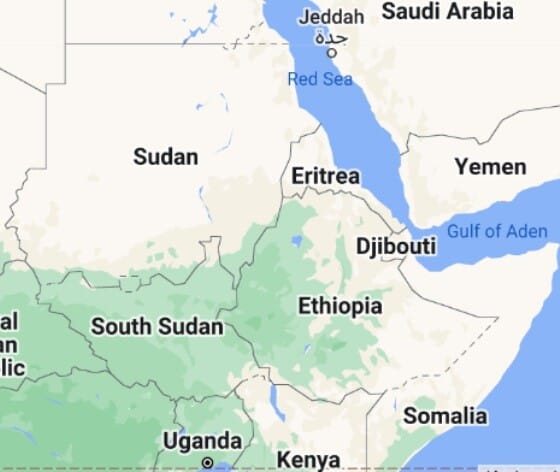By Arlene Schar and Dr. David Leffler
Despite ongoing efforts to resolve tensions and stabilize Sudan, longstanding divisive issues remain largely unresolved, and civil war persists. Achieving a sustainable and lasting peace remains challenging. It is crucial to quickly reduce the rising tensions to prevent further dangerous escalation and put an end this 14-month conflict.
 Why has it been so challenging to alleviate tensions? At its core, the root cause of social violence is the buildup of collective social stress. Addressing this human issue demands a human-centered solution. (See: “Peace through health: traditional medicine meditation in the prevention of collective stress, violence, and war” published in Frontiers in Public Health.)
Why has it been so challenging to alleviate tensions? At its core, the root cause of social violence is the buildup of collective social stress. Addressing this human issue demands a human-centered solution. (See: “Peace through health: traditional medicine meditation in the prevention of collective stress, violence, and war” published in Frontiers in Public Health.)
The best approach to eliminating social problems like war, conflict, terrorism, and crime is to directly reduce societal, collective stress—quickly and efficiently.
Extensive scientific research suggests that the most effective way to reduce collective societal stress, eliminate extremism, and eradicate war, conflict and terrorism is through an ancient strategy. The non-religious approach known as Invincible Defense Technology (IDT), revived by the late Maharishi Mahesh Yogi, has been successfully and quietly used by individuals from many faiths to resolve conflicts in the past. It is now time to consider this brain-based technology to help create lasting peace in Sudan.
We can reduce societal tensions and end the civil war in Sudan by establishing a Prevention Wing of the Sudanese Military or, if necessary, in the Military of a neighboring country. This special unit would be trained in the Transcendental Meditation (TM®) program and its advanced techniques, including the TM-Sidhi® program. This IDT approach has been extensively field-tested, even in war-torn regions like the Middle East. Extensive research has shown that when large groups practice these techniques twice daily, there is a measurable influence of harmony and peace in society: crime rates drop, quality-of-life indicators improve, and war and terrorism decrease. This large group practice appears to create a “field effect of consciousness” that extends to the surrounding population, producing a demonstrable influence of peace.
For instance, an IDT intervention was examined in Washington, D.C., in 1993. Predictions were submitted in advance to government leaders and newspapers. An independent Project Review Board approved the research protocol. When the group’s size peaked, crime dropped 24 percent below the forecasted level. Changes could not be explained by temperature, weekend effects, or previous data trends. The results were published in Social Indicators Research.
A study published in Studies in Asian Social Science reviewed previous empirical tests of IDT in Cambodia, India, the Philippines, and other countries. The findings align with earlier peer-reviewed research, showing significant reductions in crime and violence associated with the group practice of the TM and TM-Sidhi programs.
The World Journal of Social Science published a study demonstrating that when √1% of a population practiced IDT together, multiple stress indicators in the U.S. decreased. Subsequently, when the size of the IDT group decreased, these stress indicators increased again. Other factors such as economic conditions, political leadership, and demographics were considered but could not account for these results. The consistent pattern of stress indicators decreasing and then increasing in sync with changes in the size of the IDT group strongly suggests that the group itself was responsible for this effect.
Twenty peer-reviewed studies, many of which are listed here, have validated the effectiveness of IDT. Although the exact causal mechanism is not entirely understood, other research has demonstrated that practicing TM enhances EEG coherence (refer to the International Journal of Psychological Studies and International Journal of Neuroscience). This biological effect, combined with the deep rest provided by the practice, helps reduce stress and tension, boosts alertness, and enhances wellbeing and resilience in individuals.
A study in the Journal of Social Behavior and Personality (JSBP) provides a possible biological explanation for the causality of IDT. Research on the neurotransmitter serotonin indicates that it is involved in feelings of happiness, contentment, and well-being, while low serotonin levels are associated with violence, aggression, and depressed emotional states. The JSBP study found that higher numbers of IDT practitioners in the group meditation correlated with increased serotonin production among community members who were not practicing meditation and knew nothing about the group numbers. The opposite relationship was found for levels of cortisol, a stress-related hormone. When group numbers decreased, cortisol level increased. These statistically significant changes, which followed periods of higher attendance, suggest a plausible, stress-related, neurophysiologic mechanism for the reduction of aggression and hostility in society.
IDT’s global impact was documented in a study published in the Journal of Offender Rehabilitation using data from the Rand Corporation. Between 1983 and 1985, when the size of large IDT assemblies surpassed the threshold predicted to produce a measurable global effect, deaths from worldwide terrorism decreased by 72%, international conflict decreased by 32%, and violence in other countries was reduced without external government intervention.
The IDT approach also offers tangible personal benefits for military personnel and civilians affected by the aftermath of conflict and war. For instance, Post-Traumatic Stress Disorder (PTSD) is frequently observed among veterans and civilians alike. According to a study in The Lancet, a non-trauma-focused therapy, TM, could be a promising option for reducing PTSD symptoms into the normal range in veterans with PTSD and serves as an effective alternative for those veterans who choose not to receive, or do not respond to, the common prolonged-exposure-based PTSD treatments.
Military forces are entrusted with the duty of safeguarding their nations. It is their responsibility to rigorously explore practical, scientifically proven methods to eliminate war and terrorism. Military personnel are compensated for their service and the protection of their countries. Given their funding for this purpose, we believe it is incumbent upon nations’ Militaries to establish IDT Prevention Wings within their armed forces.
We strongly encourage any military to promptly implement the IDT approach to stabilize the volatile situation in Sudan.
Ideally, a synchronized practice of IDT by 15,000 advanced TM meditators twice daily would suffice to generate a global coherence effect, initiating a phase transition towards lasting world peace across all nations. Once this shift occurs, the military that first initiates such a large deployment of IDT would gain international recognition not only for fostering enduring peace domestically but also for their pivotal role in averting escalating global conflicts and potentially safeguarding our endangered planet from extinction.
About the Authors:
Arlene J. Schar is the Director of Communications at the Center for Advanced Military Science (CAMS)
Dr. David Leffler is the Executive Director at CAMS (https://www.istpp.org/military_science/).




This is an excellent article. An Antidote to Violence: Evaluating the Evidence looks at these ideas in more detail
Consider the evidence in Mozambique: with the application of this technology the civil war of 17 years ended. This result has been shown also in N. Ireland and in support of negotiations around the world. We humans have the ability to literally end war and violence and create a climate for working out major differences.
This article goes to the heart of the root cause of violence and conflict. It is excellent. Another book with sections that reinforce the research presented in this article is ‘Creating A Happy World: Cultivating Happiness through the Transcendental Meditation Program.’
Thank you!!! Got rid of Hsv,
It is good to see this scientific approach to peace, and helpful to have links to original research articles. The military and political leadership of every country should know about this. It may be the solution to the problem of violence within and among nations. Everyone has been wishing for this for a long time!